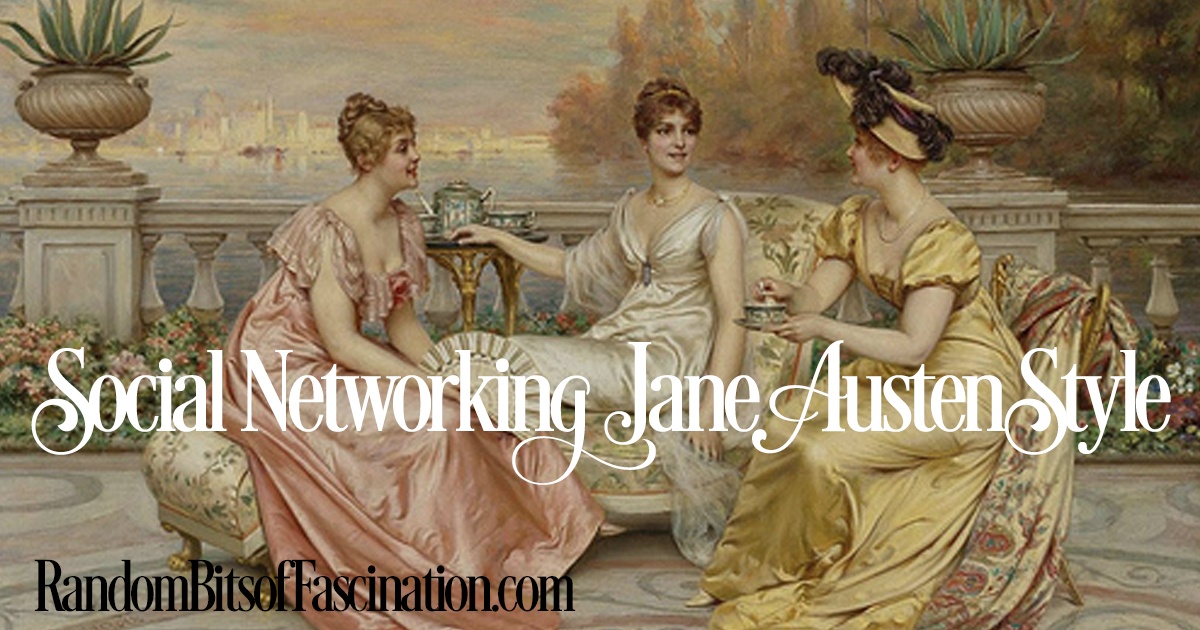The Fine Art of Conversation

Regency social life meant a constant whirl of public and private engagements. Those who aspired make a mark in society needed to be able to intelligently converse on a wide variety of subjects of general interest.
The importance of conversation

Through the Georgian era, upper-class England became an increasingly sociable environment. In order to succeed in society, individuals needed to be able to converse in an intelligent, well-informed and persuasive manner on a wide variety of subjects of general interest. “While the rich could send their children on The Grand Tour of Europe to provide them with the necessary knowledge and polish, the less wealthy turned to reading as a means of achieving a similar outcome.” (Savage, 2018)
The whole purpose of conversation was to please other people and to be deemed pleasing while doing so. “One of the hallmarks of politeness was to avoid sectarianism, bigotry and conversations likely to lead to angry quarrels. Civility demanded that any disagreements should be limited to rational discussions, and be capable of an amicable resolution. Then, as now, one of the quickest ways to ruin a pleasant conversation was to introduce politics or religion.” (Savage, 2018) Furthermore, talkativeness was considered irksome, as was overzealousness, not displaying a good nature or consideration for one’s hosts, and not knowing when to stop. (Vickery, 1998) “Magazines and handbooks were written to help ordinary people improve their conversation skills. They circulated the same tips we know today: don’t interrupt, listen to others, take turns, be agreeable.” (Mee and Smith, 2018)
Topics of Polite conversation
So, then what did one talk about to avoid social faux pax? Beyond the weather, of course, since that seems like a relatively neutral sort of topic.

In some ways it was easier to describe what was not appropriate to talk about. Polite individuals did not ask direct personal questions of recent acquaintances. To question or even compliment anyone else on the details of their dress might be regarded as impertinent. Personal remarks, however flattering, were not considered good manners. Etiquette manuals counseled such comments should be exchanged only with close family and intimate friends.
Unsurprisingly, scandal and gossip were deemed inappropriate topics of conversation. Any references to pregnancy, childbirth, or other natural bodily functions were considered coarse and carefully sidestepped. Proper ladies were expected to be shocked at the mention of anything evil, sexual, compromising or related to bodily functions. Ladies were even warned against blowing their nose in company for similar reasons. Moreover, laughter was moderated in polite company, particularly among women. Sounds like it could get a little dull, doesn’t it?
After a list like that, what was left?
Politeness demanded a visitor inquire after the health of absent members of the household. A place to start, but not exactly fulfilling conversation.
A more promising source of conversation might be found in the drawing room itself. “People filled their homes with objects to encourage lively talk: perhaps a family portrait done in the new informal style of the ‘conversation piece’.” (Mee and Smith, 2018) One might carefully make observation on the contents of a room, even inquiring after the source or story behind interesting pieces. Afterall, everyone likes to be invited to talk about their treasures.
Well-read individuals might discuss what they have read as Anne Elliot and Captain Benwick in Austen’s Persuasion. Opinions and interpretation of literature, or even the latest novel might make excellent conversation. Those whose taste in reading leaned toward nonfiction might discuss the latest essay or travelogue they had read, as long as it did not lean toward uncomfortable quarrels, it could make for good conversation.
Dinner time conversation

During dinner, some special conversational rules applied. A gentleman was expected to entertain the ladies nearest him with engaging conversation. It was not polite to talk behind one guest’s back to another, still less to shout down the table or even to talk across the table. To reduce general noise and confusion, the rules of protocol set forth that during the first course, the conversation would flow to the hostesses’ left. When the second course was set, the hostess would turn to the guest on her right, thus “turning the table” and conversation would flow to her right. The rules of polite conversation would of course be in force at the dinner table.
So, what do you think? How would you fair at the Regency dinner table or in the drawing room?

I would be bored to tears! I do enjoy reading so that might help, but I would probably be thrown out since I read about politics. One can only discuss so many mystery novels. Of course, I could discuss my cat’s adventure with tape worms. Ugh!
I would not fair well at all. However, what strikes me when reading this is the fact Caroline Bingley flaunts the protocol of polite society at every turn. She supposedly went to this Ladies Seminary and apparently didn’t learn a thing. I see her faux pax at every turn. This was a very informative post. I might not abide by that society for myself; however, I enjoy reading the rules so I can scream/laugh at those who do flaunt them. Thanks for sharing.
Knowing the rules, Jane Austen’s contemporaries would automatically understand much about her characters when they read the novels. Some of the rules apply today but not all, so we have an incomplete understanding without the knowledge you just shared. Thank you. Now I think of the worst of them— Mr Collins and Lady Catherine along with Mrs Bennet and Lydia. And I wonder why Elizabeth didn’t recognize Wickham for what he was earlier. But Lizzy certainly recognizes Darcy’s insult at the assembly.
Pingback:In Her Own Hand: The Power of a Well Written Letter - Random Bits of Fascination